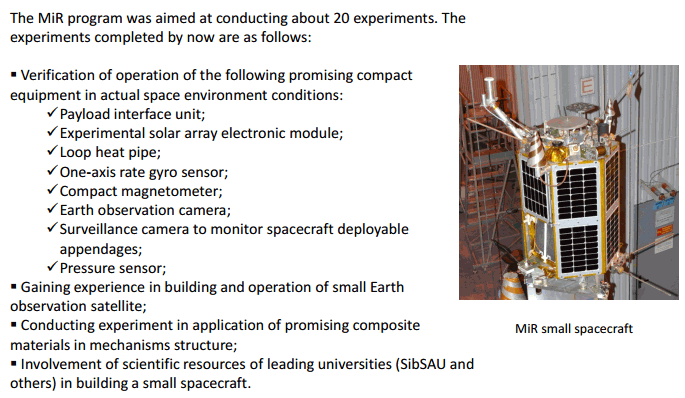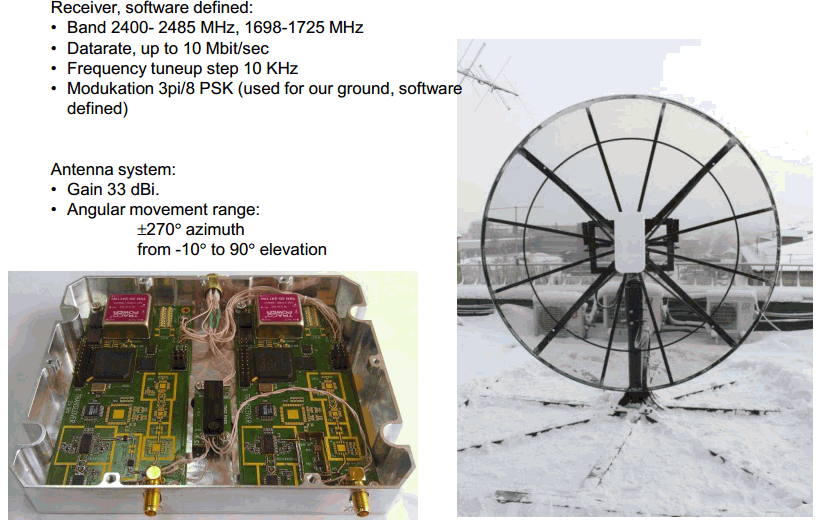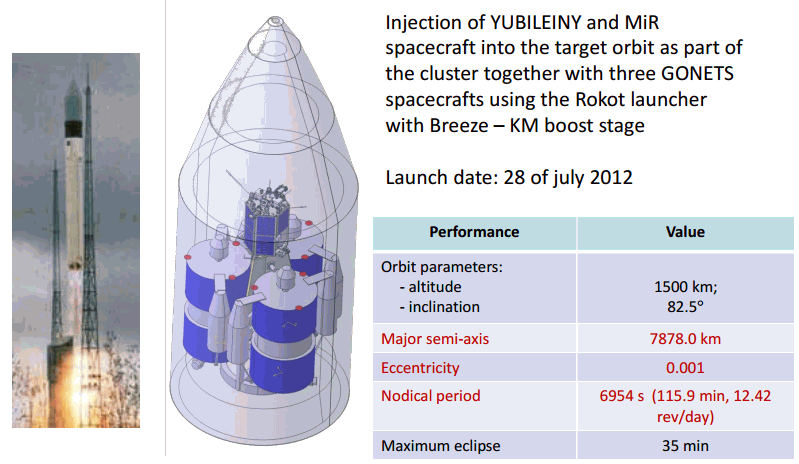NASA Catalog: 38735

The light-weight launcher lifted off on July 28, 2012, at 05:35:00 Moscow Time (01:35 GMT) from Pad 3 at Site 133 in Plesetsk. According to official reports, it carried a pair of Gonets-M communications satellites for the Gonets-D1M multifunction network, MSPSS, and a MiR (Mikhail Reshetnev, a.k.a. Yubileiny-2) remote-sensing spacecraft. A classified military satellite was also announced to be onboard. According to Russian sources, it belonged to the Strela communications network and similar to civilian Gonets satellites. Russian space agency, Roskosmos, confirmed that both Gonets payloads and MiR successfully reached the orbit, separating from their upper stage at 07:19 Moscow Time on July 28. For Gonets the operational orbit has an altitude of 1,500 kilometers and an inclination 82.5 degrees toward the Equator. Industry sources confirmed that the first communication session between ground control and MiR (Yubileiny-2) satellite had been conducted successfully. The launch was previously planned for June 30, but slipped to July 13 and then to July 28, primarily due to issues with avionics onboard Rockot’s Briz-KM upper stage.
The Yubileiny-2 experimental micro-satellite, later known as MiR, was designed for remote-sensing of the Earth among its goals. It was expected to be used for educational student projects. Siberian State Aerospace University, SibGAU, supplied key systems for the satellite, employing its students in various stages of the development process. SibGAU developed a laser reflector, the main payload control unit, a power supply unit, two small web cameras, remote-sensing camera for the satellite.
Downlink
435.265 MHZ (TXA) und 435.365MHz (TXB) CW und FM (Data)
Status
nicht aktiv
Orbital Parameter
NORAD 38735 COSPAR designator 2012-041-C Inclination 82.473 RA of A. Node 310.729 Eccentricity 0.0016931 Argument of Perigee 339.147 Revs per day 12.42559042 Period 1h 55m 53s (115.88 min) Semi-major axis 7 874 km Perigee x Apogee 1 482 x 1 509 km BStar (drag term) 0.000100000 1/ER Mean anomaly 20.892

CW Telemetrie
Name Decoding parameters Assignment of parameters ------------------------------------------------------------------ RS 40 Callsign UBS U=N * 0.1 Volts On board voltage IBS I=N * 0.01 Amp On board current USUN U=N * 0.1 Volts Charge voltage from solar array ISUN I=N * 0.01 Amp Charge current from solar array ITXA I=N * 0.01 Amp DC Current of the 435 MHz Tx A ITXB I=N * 0.01 Amp DC Current of the 435 MHz Tx B TTXA T=N-128 °C Temperature of the 435 MHz Tx A TTXB T=N-128 °C Temperature of the 435 MHz Tx B TNAP T=N-128 °C Temperature of the navigation unit TAB T=N-128 °C Temperature on board battery MSEP Table of operational modes of the power supply MCON Table of operational modes of the controller SMA Table of operational modes of channel A SMB Table of operational modes of channel B MRXA Table of operational modes of Rx A (435.315 MHz) MRXB Table of operational modes of Rx B (435.215 MHz) RS 40 Callsign
Datenübertragung
Modulation PM Manchester kodiert 4800 kbit/s (FM) 1136 bytes frame length
Ein kompletter Übertragungszyklus besteht aus 256 Frames inkl. Syncword und Framecounter. Ein kompletter Telemetriesatz besteht aus 128 x 256 Bytes (Daten aus 2 Rahmen).


08.09.2013: telemetry channel (byte #81)
Nur im Bereich der Kommandostation aktiv. Die Übermittlung der wissenschaftlichen Meßdaten von RS-40-M findet außerhalb des Amateurfunkbereiches im S-Band auf 2270 MHz statt. Die primäre S-Band Tracking Station befindet sich in Krasnoyarsk.

Launch

weitere Informationen
http://www.russianspaceweb.com/yubileiny.htmlhttps://directory.eoportal.org/web/eoportal/satellite-missions/v-w-x-y-z/yubileiny-2
